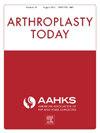The Effect of Chronic Anticoagulation on Early Postoperative Outcomes Following Total Knee Arthroplasty: A TriNetX Database Study
IF 2.1
Q3 ORTHOPEDICS
引用次数: 0
Abstract
Background
Medications used for pharmacologic venous thromboembolism prophylaxis are associated with postoperative complications including bleeding, wound complications, and infection. These same medications are used for chronic anticoagulation, and little research has been done on total knee arthroplasty (TKA) complications associated with these medications, particularly manipulation under anesthesia (MUA) and revision TKA. The purpose of this study is to evaluate the rate of MUA and other early postoperative complications in patients undergoing TKA with a preoperative history of chronic anticoagulation.
Methods
The TriNetX database was retrospectively queried for all patients undergoing TKA with perioperative tranexamic acid. Patients were divided into cohorts by whether or not they had a history of chronic anticoagulant use and had an anticoagulant medication prescribed within 6 months of surgery. The cohorts were propensity score matched on demographic and comorbidity data; 7367 patients remained in each cohort after matching.
Results
Patients with chronic anticoagulant use were 1.72 times more likely to undergo an MUA (odds ratio [OR]: 1.718, 95% confidence intervals [CI]: 1.403-2.104; P < .001), 1.32 times more likely to have a revision TKA (OR: 1.324, 95% CI: 1.006-1.742; P = .044), and were 1.53 times more likely to have wound disruption (OR: 1.530, 95% CI: 1.214-1.927; P < .001) within the 1-year postoperative period.
Conclusions
Patients undergoing TKA while on chronic anticoagulation have worse outcomes within 1 year postoperatively than patients not on chronic anticoagulation. Further studies are needed to validate these findings and to identify sources of the increased risk of complications in this population, as well as identify factors that may mitigate this risk.
慢性抗凝对全膝关节置换术术后早期预后的影响:一项TriNetX数据库研究
用于静脉血栓栓塞药理学预防的药物与术后并发症相关,包括出血、伤口并发症和感染。这些相同的药物也用于慢性抗凝,并且很少有研究与这些药物相关的全膝关节置换术(TKA)并发症,特别是麻醉下操作(MUA)和改良TKA。本研究的目的是评估术前有慢性抗凝史的TKA患者MUA及其他术后早期并发症的发生率。方法回顾性查询TriNetX数据库中所有围手术期应用氨甲环酸的TKA患者。根据患者是否有慢性抗凝血使用史,以及是否在手术后6个月内服用过抗凝血药物,将患者分为两组。这些队列在人口学和合并症数据上进行倾向评分匹配;配对后,每个队列中仍有7367例患者。结果长期使用抗凝剂的患者发生MUA的可能性是使用抗凝剂的患者的1.72倍(优势比[OR]: 1.718, 95%可信区间[CI]: 1.404 -2.104;P & lt;.001),有修订TKA的可能性增加1.32倍(OR: 1.324, 95% CI: 1.006-1.742;P = 0.044),创面破裂的可能性为1.53倍(OR: 1.530, 95% CI: 1.214-1.927;P & lt;.001)。结论经TKA合并慢性抗凝治疗的患者术后1年内预后较不经慢性抗凝治疗的患者差。需要进一步的研究来验证这些发现,并确定该人群并发症风险增加的来源,以及确定可能减轻这种风险的因素。
本文章由计算机程序翻译,如有差异,请以英文原文为准。
求助全文
约1分钟内获得全文
求助全文
来源期刊

Arthroplasty Today
Medicine-Surgery
CiteScore
2.90
自引率
0.00%
发文量
258
审稿时长
40 weeks
期刊介绍:
Arthroplasty Today is a companion journal to the Journal of Arthroplasty. The journal Arthroplasty Today brings together the clinical and scientific foundations for joint replacement of the hip and knee in an open-access, online format. Arthroplasty Today solicits manuscripts of the highest quality from all areas of scientific endeavor that relate to joint replacement or the treatment of its complications, including those dealing with patient outcomes, economic and policy issues, prosthetic design, biomechanics, biomaterials, and biologic response to arthroplasty. The journal focuses on case reports. It is the purpose of Arthroplasty Today to present material to practicing orthopaedic surgeons that will keep them abreast of developments in the field, prove useful in the care of patients, and aid in understanding the scientific foundation of this subspecialty area of joint replacement. The international members of the Editorial Board provide a worldwide perspective for the journal''s area of interest. Their participation ensures that each issue of Arthroplasty Today provides the reader with timely, peer-reviewed articles of the highest quality.
 求助内容:
求助内容: 应助结果提醒方式:
应助结果提醒方式:


